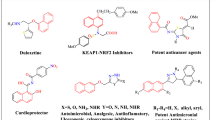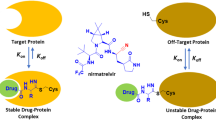Abstract
Three novel 1-benzhydryl-piperazines with xanthine moiety at N4 were synthesized and tested for 5-HT1A and 5-HT2A receptor affinity. One of the compounds showed the highest affinity (58.6 nM) and selectivity (34 times) to 5-HT2A receptor known for this class of compounds. A set of the three new and 31 previously synthesized 1-arylpiperazines with xanthine moiety at N4 was compiled and a QSAR study was performed in order to rationalize the further synthesis. It was found that the 5-HT1A affinity depends on the shape of the molecules (ovality and number of circuits), the distribution of the electron density in the structures (partial charges at piperazine N1 and xanthine N1) and their charge transfer ability (HOMO energy). The 5-HT2A affinity depends on the lipophilicity of the ligands and the distribution of the electron density in the structures (partial charges at piperazine N4 and xanthine O6). The QSAR results are in a good agreement with known pharmacophore models.
Graphical Abstract





Similar content being viewed by others
References
Bodor N, Gabanyi Z, Wong C-K (1989) A new method for the estimation of partition coefficient. J Am Chem Soc 111:3783–3786
Bojarski AJ (2006) Pharmacophore models for metabotropic 5-HT receptor ligands. Curr Topics Med Chem 6:2005–2026
Bojarski AJ, Cegła MT, Charakchieva-Minol S, Mokrosz MJ, Mackowiak M, Mokrosz JL (1993) Structure-activity relationship studies of CNS agents. Part 9. 5-HT1A and 5-HT2 receptor affinity of some 2- and 3-substituted 1,2,3,4-tetrahydro-β-carbolines. Pharmazie 48:289–294
Cheng Y, Prusoff WH (1973) Relationship between the inhibition constant ([K.sub.i]) and the concentration of inhibitor which causes 50 per cent inhibition ([I.sub.50]) of an enzymatic reaction. Biochem Pharmacol 22:3099–3108
Chlon G, Pawlowski M, Duszynska B, Szaro A, Tatarczynska E, Klodzinska A, Chojnacka-Wojcik E (2001) Synthesis, 5-HT1A and 5-HT2A receptor activity of new 1-phenylpiperazinylpropyl derivatives with arylalkyl substituents in position 7 of purine-2, 6-dione. Pol J Pharmacol 53:359–368
Chojnacka-Wojcik E, Klodzinska A, Drabczynska A, Pawlowski M, Charakchieva-Minol S, Chlon G, Gorczyca M (1995) A new putative 5-HT1A receptor antagonist of the 1-arylpiperazine class of ligands. Eur J Med Chem 30:587–592
Daly JW (2007) Caffeine analogs: biomedical impact. Cell Mol Life Sci 64:2153–2169
Dewar MJS, Zoebisch EG, Healy EF, Stewart JJP (1985) AM1: A new general purpose quantum mechanical model. J Am Chem Soc 107:3902–3909
Gagausov J, Peikov P, Davkov D, Sharankov K (1987) Synthesis of 8-brom-methylxanthines. Farmacia (Sofia) 37:8–10
Glennon RA, Westkaemper RB, Bartyzel P (1991) Medicinal chemistry of serotonergic agents. In: Peroutka SJ (ed) Serotonin receptor subtypes: basic and clinical aspects. Wiley-Liss, New York, pp 19–64
Hocquet A, Langgard M (1998) An evaluation of the MM + force field. J Mol Model 4:94–112
Hoyer D, Clarke DE, Fozard JR, Hartig PR, Martin GR, Mylecharane EJ, Saxena PR, Humphrey PP (1994) International union of pharmacology classification of receptors for 5-hydroxytryptamine (Serotonin). Pharmacol Rev 46:157–203
Kang S, Green JP (1970) Correlation between activity and electronic state of hallucinogenic amphetamines. Nature 226:645
Kolaczkowski M, Zajdel P, Fhod O, Duszynska B, Tatarczynska E, Pawlowski M (2005) Synthesis and 5-HT1A/5-HT2A activity of some butyl analogs in the group of phenylpiperazine alkyl pyrimido[2,1-f]theophyllines. Pharmacol Reports 57:229–235
Kolb VM (1987) Electron-transfer and charge-transfer clastic binding hypotheses for drug-receptor interactions. Pharm Res 4:450–456
Leardi R, Boggia R, Terrile M (1992) Genetic algorithms as a strategy for feature selection. J Chemometrics 6:267–281
Lopez-Rodriguez ML, Ayala D, Benhamu B, Morcillo MJ, Viso A (2002) Arylpiperazine derivatives acting at 5-HT1A receptors. Curr Med Chem 9:443–469
Mokrosz JL, Strekowski L, Duszynska B, Harden DB, Mokrosz MJ, Bojarski AJ (1994) Structure-activity relationship studies of CNS agents. Part 14. Structural requirements for the 5-HT1A and 5-HT2 receptor selectivity of simple 1-(2-pyrimidinyl)piperazine derivatives. Pharmazie 49:801–806
Nagamoto T, Rashid M, Muntasir HA, Komiyama T (2004) Functions of 5-HT2A receptor and its antagonists in the cardiovascular system. Pharmacol Therap 104:59–81
Nichols DE, Nichols CD (2008) Serotonin receptors. Chem Rev 108:1614–1641
Oh SJ, Ha HJ, Chi DY, Lee HK (2001) Serotonin receptor and transporter ligands—current status. Curr Med Chem 8:999–1034
Ouagazzal A-M, Grottick AJ, Moreau J-L, Higgins GA (2001) Pharmacological analysis and comparison between two rat strains. Neuropsychopharmacol 25:565–575
Pawlowski M, Katlabi J, Drabczynska A, Duszynska B, Charakchieva-Minol S, Deren-Wesolek A, Tatarczynska E, Chojnacka-Wojcik E, Mokrosz MJ, Bojarski AJ (1999) New 9- or 10-arylpiperazinoalkyl substituted pyrimido- or diazepino[2, 1-f]purines with partial or full 5-HT1A agonistic activity. Eur J Med Chem 34:167–175
Pawlowski M, Chlon G, Obniska J, Zejc A, Charakchieva-Minol S, Mokrosz MJ (2000) Synthesis, 5-HT1A and 5-HT2A receptor affinity of new 1-phenylpiperazinylpropyl derivatives of purine-2, 6-and pyrrolidine-2, 5-diones. Il Farmaco 55:461–468
Peikov P, Sidzhakova D, Gagausov J (1988) Methods of synthesis of pentoxiphylline. Farmacia (Sofia) 38:1–4
Peikov P, Zlatkov Al, Gagausov J, Kalinkova G (1990) Preparation of some 8-(bromoalkylamino)-caffeines and infrared studies. Farmacia (Sofia) 49:1–6
Roth BL (1994) Multiple serotonin receptors: clinical and experimental aspects. Ann Clin Psychiatry 6:67–78
Acknowledgments
This work was supported by grant from the Medical Science Council of the Medical University of Sofia (project 5-I/2009).
Author information
Authors and Affiliations
Corresponding author
Rights and permissions
About this article
Cite this article
Valkova, I., Zlatkov, A., Nędza, K. et al. Synthesis, 5-HT1A and 5-HT2A receptor affinity and QSAR study of 1-benzhydryl-piperazine derivatives with xanthine moiety at N4. Med Chem Res 21, 477–486 (2012). https://doi.org/10.1007/s00044-011-9555-y
Received:
Accepted:
Published:
Issue Date:
DOI: https://doi.org/10.1007/s00044-011-9555-y




